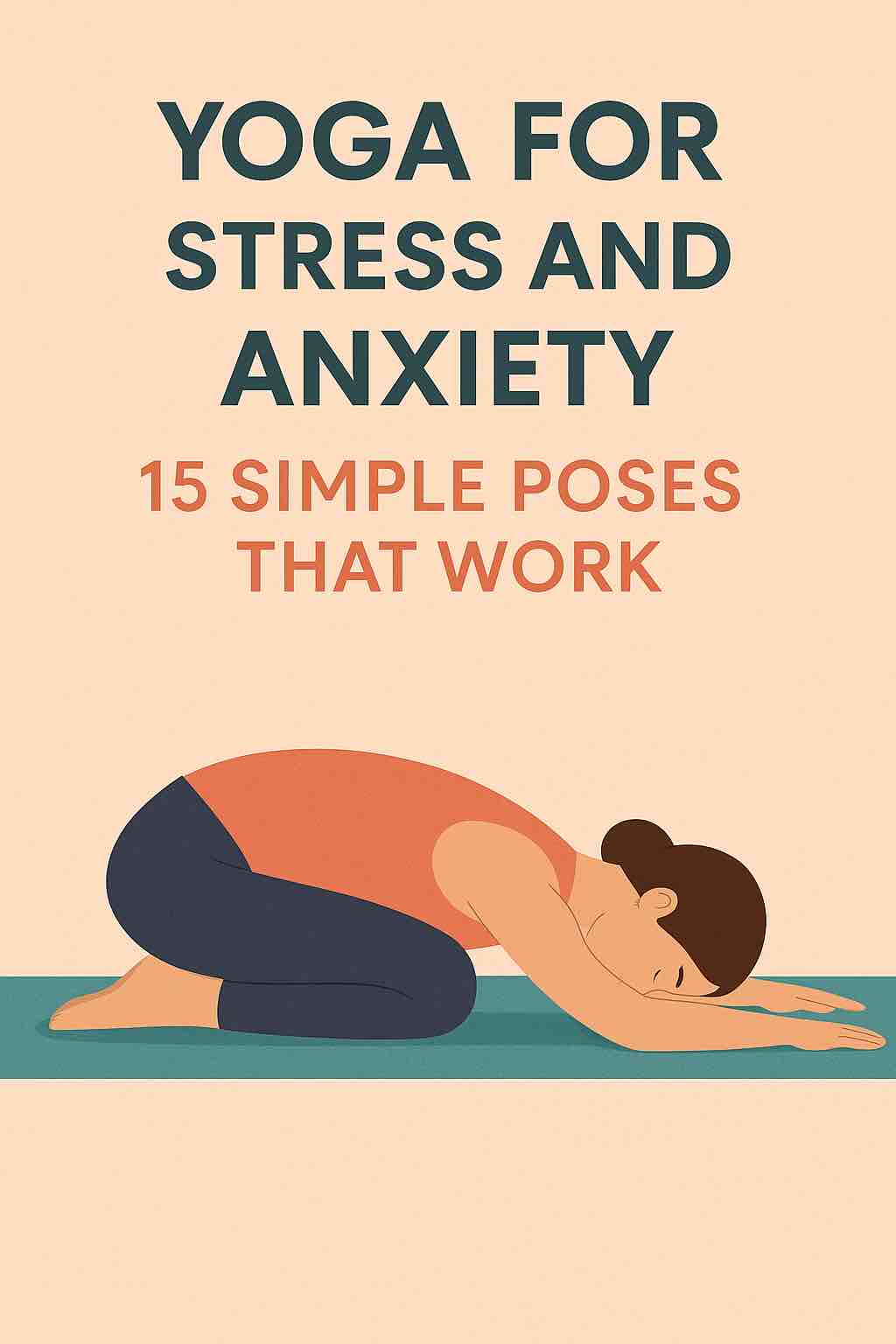
In today’s fast-paced world, stress and anxiety have become almost unavoidable. Deadlines, life challenges, and constant digital distractions can leave us overwhelmed. While medication and therapy have their place, many people are searching for natural stress relief methods — and that’s where yoga shines.
Yoga for stress and anxiety isn’t just about physical postures; it’s a holistic practice that calms the mind, balances the nervous system, and promotes emotional well-being. In this guide, you’ll discover 15 simple yet powerful yoga poses for anxiety and stress relief that you can practice at home — no prior experience required.
Why Yoga Is Effective for Stress and Anxiety
Modern science confirms what yogis have known for centuries: yoga works for stress and anxiety because it:
- Activates the parasympathetic nervous system (relaxation response)
- Lowers cortisol (stress hormone) levels
- Promotes mindful breathing (pranayama)
- Reduces muscle tension and physical discomfort
- Improves sleep and emotional resilience
- Supports mental clarity and focus
Even short sessions of calming yoga can help you regain control over racing thoughts, calm your emotions, and reduce physical symptoms of anxiety.
The 15 Simple Yoga Poses for Stress and Anxiety
1. Child’s Pose (Balasana)
One of the most calming yoga poses for anxiety.
- Releases back and shoulder tension
- Grounds the nervous system
- Encourages mindful, slow breathing
Tip: Allow your forehead to rest on a block or mat to enhance the calming effect.
Instructions:
- Kneel on your mat, big toes touching, knees wide apart.
- Sit back onto your heels.
- Slowly fold forward, bringing your forehead to the mat.
- Extend arms forward or place them alongside your body.

Breath Cue:
Inhale slowly, exhale fully, allowing your body to relax deeper with each breath.
Duration:
Hold for 1-3 minutes.
Modification:
Place a bolster or pillow under your chest for extra comfort.
2. Legs-Up-The-Wall Pose (Viparita Karani)
An excellent inversion for anxiety relief.
- Boosts circulation
- Lowers heart rate
- Eases fatigue and mental overload
Tip: Use a bolster under your hips for extra comfort.
Instructions:
- Sit sideways next to a wall.
- Swing your legs up the wall as you lower your back onto the mat.
- Adjust your distance so your hips are close to the wall.
- Rest arms by your sides, palms facing up.

Breath Cue:
Inhale deeply into your belly, exhale slowly and completely.
Duration:
Hold for 5-10 minutes.
Modification:
Place a folded blanket under your hips for gentle elevation.
3. Cat-Cow Stretch (Marjaryasana-Bitilasana)
A gentle, flowing movement that releases spinal tension.
- Syncs breath with movement
- Loosens up the back and neck
- Improves emotional balance
Tip: Move slowly and mindfully for the best stress-relieving effect.
Instructions:
- Start on all fours (hands under shoulders, knees under hips).
- Inhale: Drop the belly, lift the chest and tailbone (Cow).
- Exhale: Round the spine, tuck the chin and tailbone (Cat).
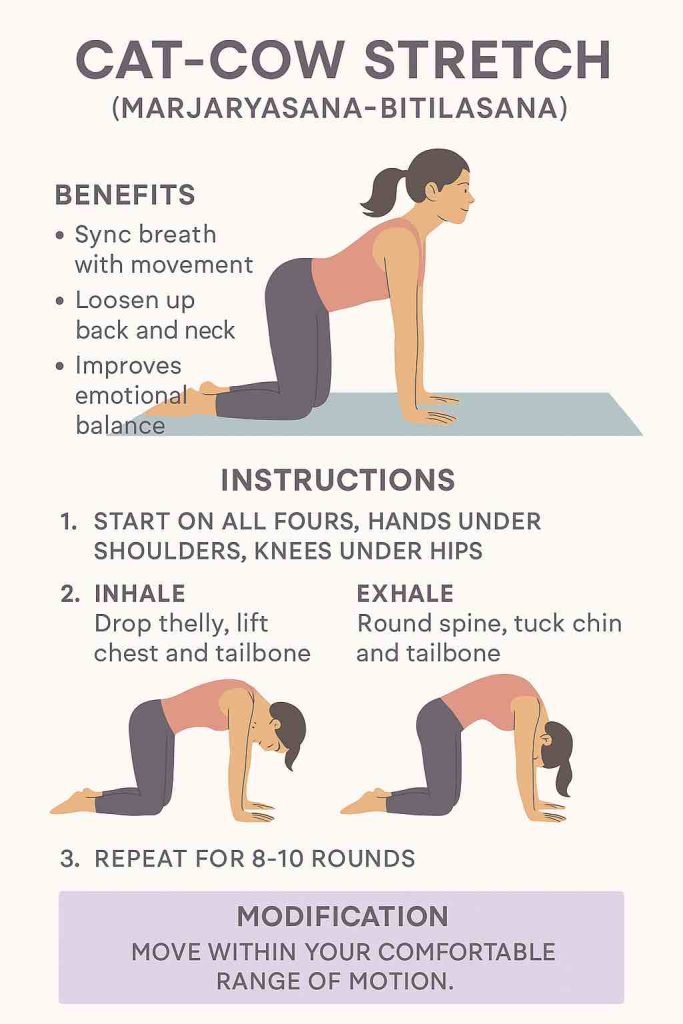
Breath Cue:
Inhale into Cow; exhale into Cat.
Duration:
8-10 slow rounds.
Modification:
Move within your comfortable range of motion.
4. Seated Forward Bend (Paschimottanasana)
Encourages deep inward focus, perfect for calming anxiety.
- Stretches the back and hamstrings
- Relaxes the mind
- Reduces tension headaches
Modification: Sit on a folded blanket if you have tight hamstrings.
Instructions:
- Sit with legs extended in front.
- Inhale to lengthen your spine.
- Exhale, hinge at hips, and fold forward gently.
- Let your hands rest on shins, ankles, or feet.
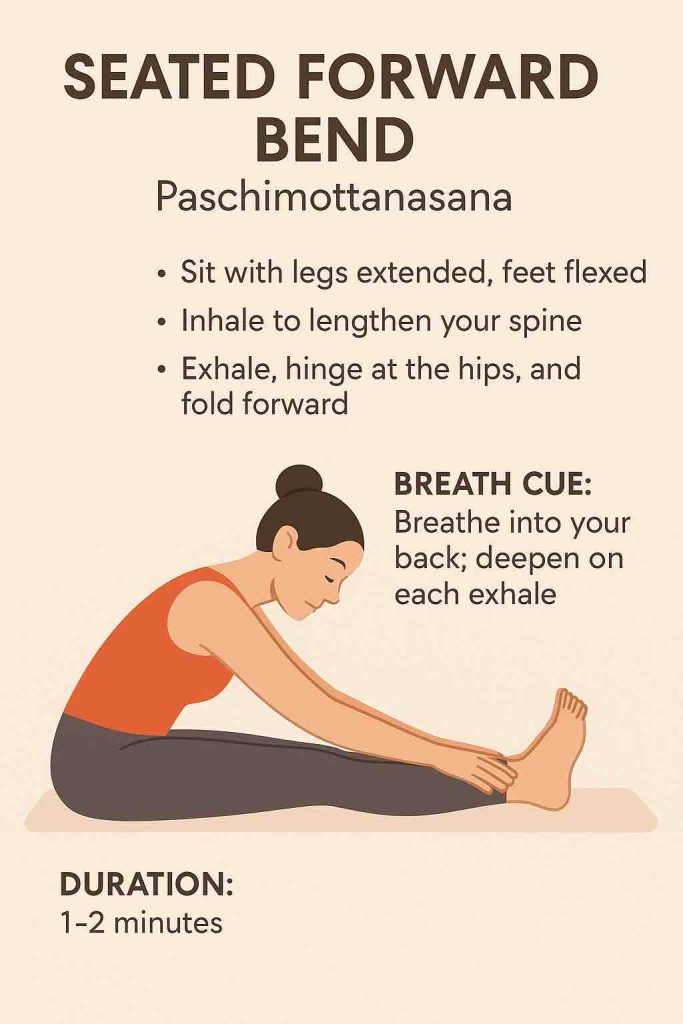
Breath Cue:
Breathe into your back; soften deeper on each exhale.
Duration:
Hold for 1-2 minutes.
Modification:
Sit on a cushion or place a strap around your feet.
5. Bridge Pose (Setu Bandhasana)
Both energizing and calming, depending on your breath.
- Opens chest and heart space
- Improves thyroid function
- Reduces anxiety symptoms
Tip: Place a block under your sacrum for a supported version.
Instructions:
- Lie on your back, knees bent, feet hip-width apart.
- Press feet and arms into the floor.
- Inhale, lift your hips toward the ceiling.
- Interlace fingers under your back for more opening.
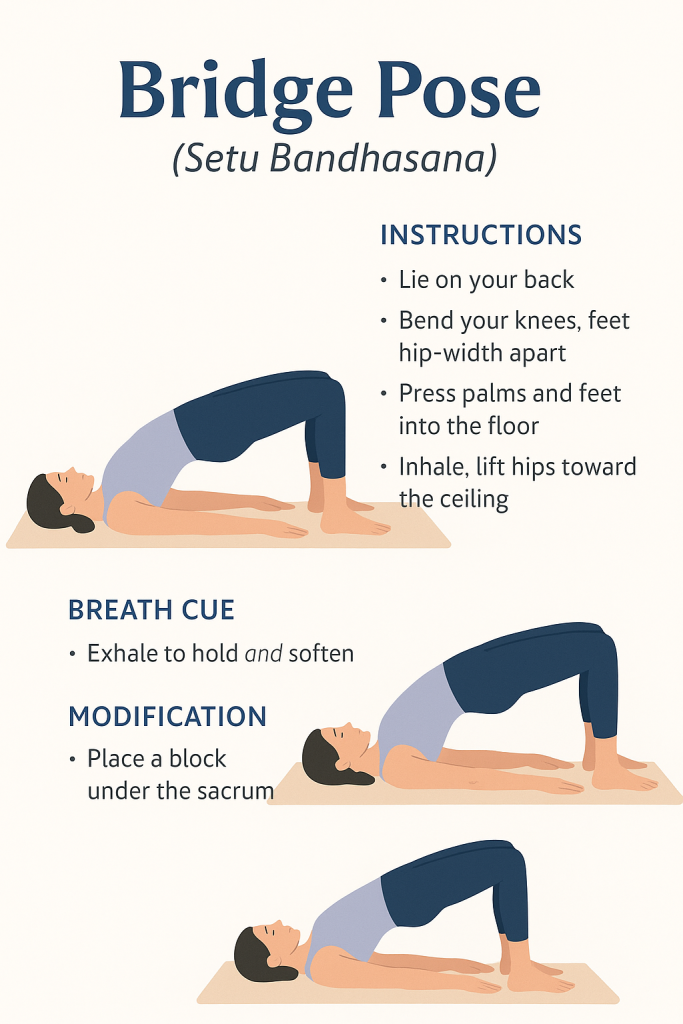
Breath Cue:
Inhale on the lift, exhale to hold and soften.
Duration:
Hold for 30 seconds to 1 minute.
Modification:
Place a yoga block under your sacrum for a supported bridge.
6. Reclining Bound Angle Pose (Supta Baddha Konasana)
Great for releasing tension in the hips.
- Promotes relaxation
- Deepens breathing
- Gently opens chest and groin
Modification: Support knees with blocks or pillows.
Instructions:
- Lie on your back.
- Bring soles of the feet together, allowing knees to open outward.
- Place pillows or blocks under knees for support.
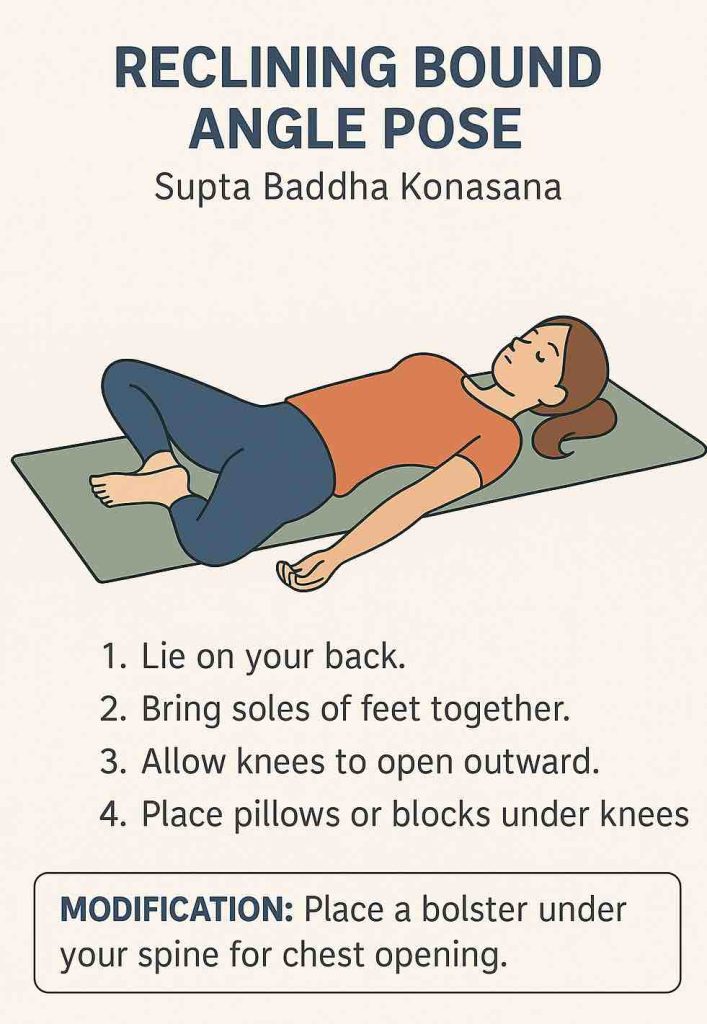
Breath Cue:
Breathe deeply into your lower belly.
Duration:
3-5 minutes.
Modification:
Place a bolster under your spine for additional chest opening.
7. Standing Forward Fold (Uttanasana)
Encourages blood flow to the brain.
- Soothes the nervous system
- Relieves tension in back and neck
- Promotes mental clarity
Tip: Slightly bend your knees to avoid straining the hamstrings.
Instructions:
- Stand with feet hip-width apart.
- Inhale, lengthen spine; exhale, fold from hips.
- Let arms dangle or hold opposite elbows.
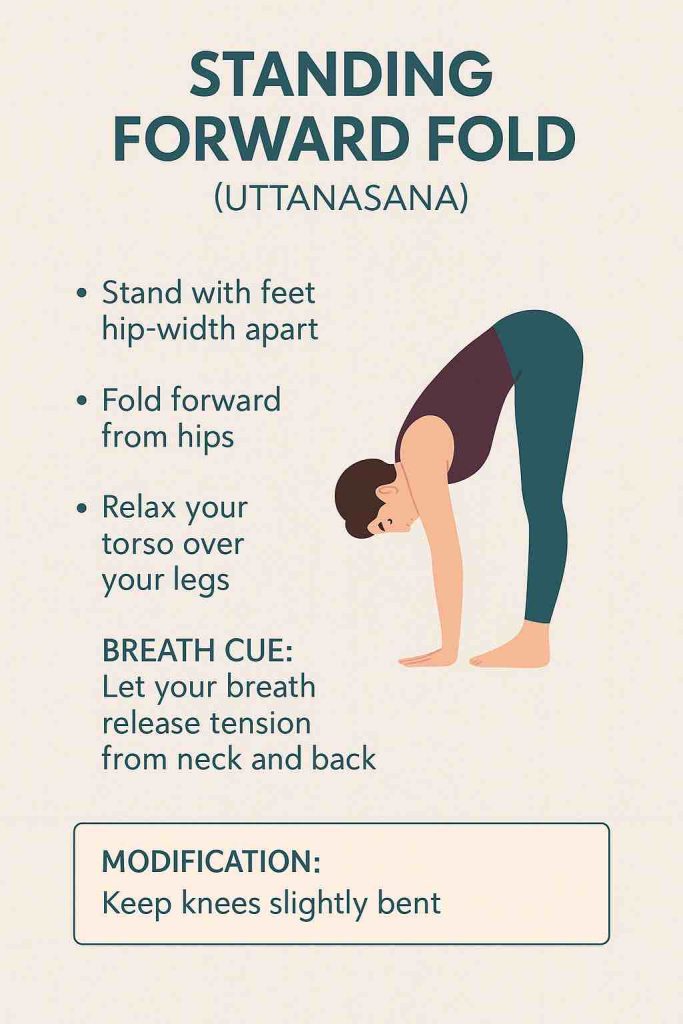
Breath Cue:
Let your breath release tension from your neck and back.
Duration:
Hold for 1-2 minutes.
Modification:
Keep knees slightly bent for tight hamstrings.
8. Corpse Pose (Savasana)
Essential for stress management and full relaxation.
- Completely relaxes body and mind
- Lowers blood pressure
- Helps integrate the entire practice
Tip: Cover yourself with a light blanket to stay warm and grounded.
Instructions:
- Lie flat on your back, legs extended, arms at sides.
- Palms face up, feet naturally falling outward.
- Close your eyes and fully relax.
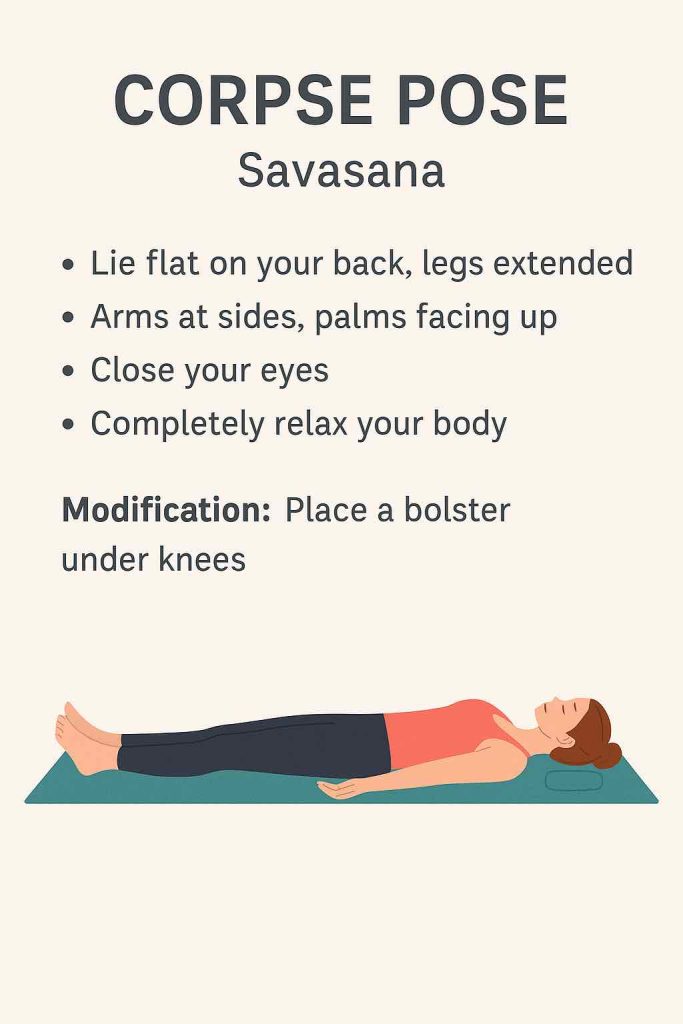
Breath Cue:
Allow breath to slow naturally without control.
Duration:
5-10 minutes.
Modification:
Place a bolster under knees for lower back support.
9. Easy Seated Pose (Sukhasana) with Breath Awareness
An accessible meditation posture.
- Grounds the mind
- Stabilizes emotions
- Builds mindfulness
Practice: Inhale deeply for 4 counts, exhale slowly for 6 counts.
Instructions:
- Sit cross-legged on the floor or cushion.
- Sit tall, shoulders relaxed.
- Place hands on knees or lap.
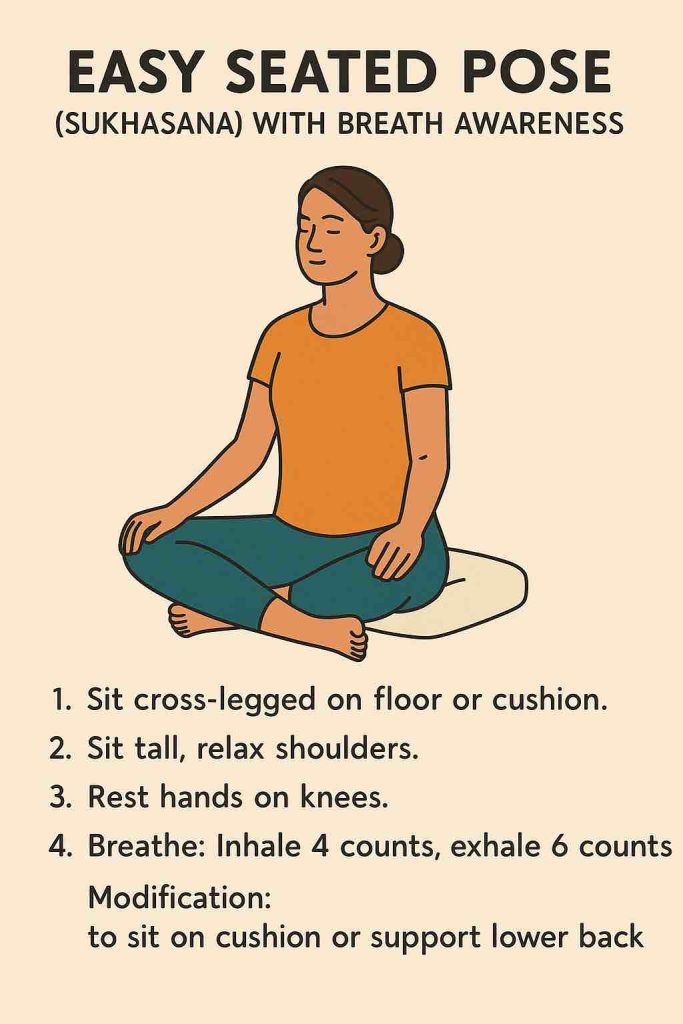
Breath Cue:
Inhale 4 counts, exhale 6 counts.
Duration:
5 minutes.
Modification:
Sit against a wall for back support if needed.
10. Supine Twist (Supta Matsyendrasana)
Gently unwinds the spine and nervous system.
- Alleviates back discomfort
- Promotes digestion
- Calms anxiety and racing thoughts
Tip: Breathe deeply into your belly while twisting.
Instructions:
- Lie on your back.
- Bring knees to chest.
- Drop knees gently to one side; arms open wide.
- Turn head opposite to knees.

Breath Cue:
Breathe into your belly, allow ribs to expand.
Duration:
1-2 minutes per side.
Modification:
Place pillows under knees for support.
11. Mountain Pose (Tadasana) with Grounding Visualization
Deceptively simple but powerful for grounding.
- Improves posture and confidence
- Anchors you in the present moment
- Stabilizes emotional fluctuations
Visualization: Imagine roots growing from your feet into the earth.
Instructions:
- Stand tall, feet hip-width apart.
- Engage thighs, lengthen spine.
- Relax shoulders and arms.

Breath Cue:
Inhale deeply, imagine grounding into the earth on each exhale.
Duration:
Hold for 30-60 seconds.
Modification:
Practice barefoot for stronger grounding sensation.
12. Thread-the-Needle Pose
Targets shoulder and upper back tension, often linked to chronic stress.
- Releases trapped tension
- Opens shoulders gently
- Calms upper body tightness
Modification: Use a block or bolster for support.
Instructions:
- Begin on all fours.
- Slide right arm under left arm, palm facing up.
- Lower shoulder and temple to the floor.
- Keep hips stacked.
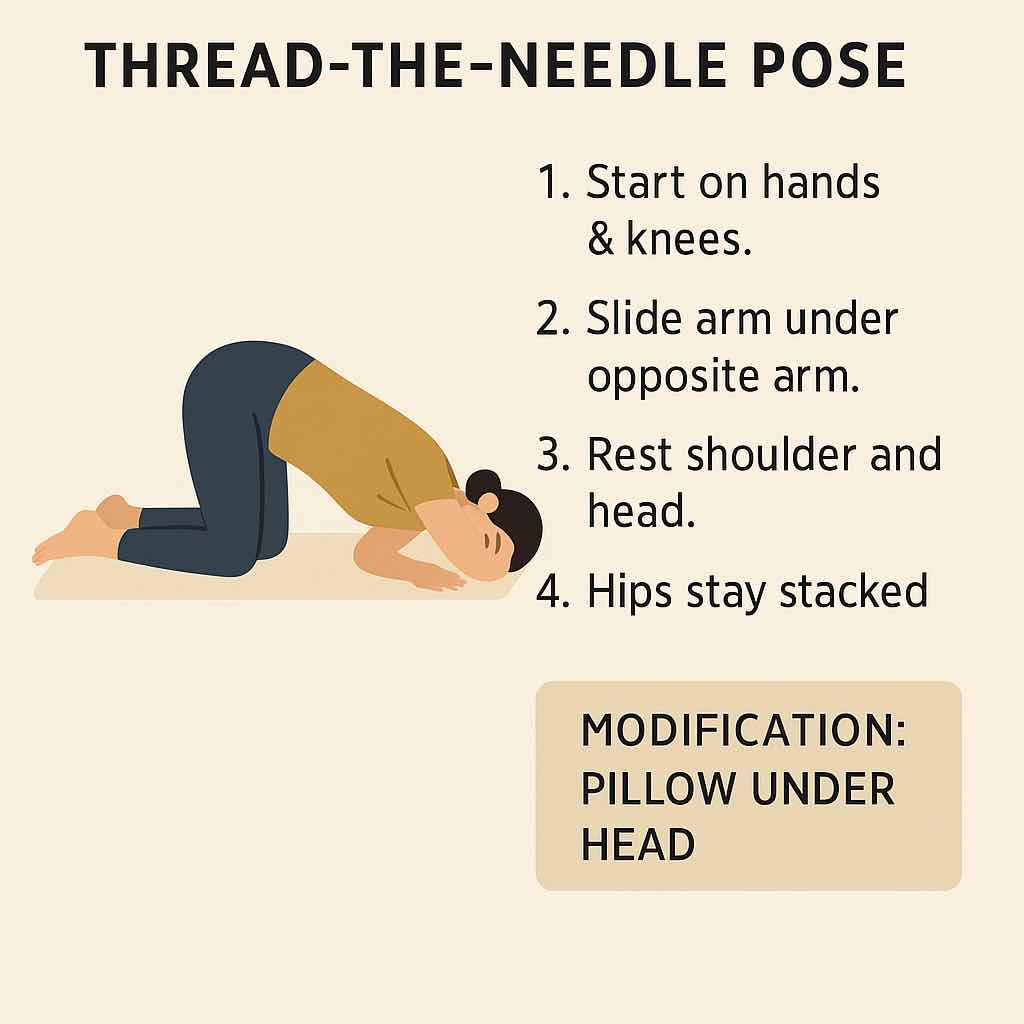
Breath Cue:
Inhale into upper back, exhale and soften deeper.
Duration:
1-2 minutes per side.
Modification:
Use a pillow under your head for comfort.
13. Supported Fish Pose (Matsyasana) with Bolster
Opens the chest and improves breathing capacity.
- Releases tight chest muscles
- Improves heart function
- Eases emotional stress
Tip: Use a bolster or stacked pillows for gentle elevation.
Instructions:
- Place a bolster lengthwise on mat.
- Sit in front, lower back onto bolster, head supported.
- Allow arms to open wide.

Breath Cue:
Breathe fully into chest and ribcage.
Duration:
3-5 minutes.
Modification:
Support lower back or neck as needed.
14. Alternate Nostril Breathing (Nadi Shodhana Pranayama)
A powerful breathing technique for anxiety relief.
- Balances left and right brain hemispheres
- Reduces anxiety quickly
- Restores mental focus
Practice: Close one nostril, inhale through the other, switch, and exhale. Repeat for 3-5 minutes.
Instructions:
- Sit comfortably.
- Use right hand: thumb closes right nostril, ring finger closes left.
- Inhale through left, close, exhale through right.
- Inhale right, close, exhale left.

Breath Cue:
Focus on smooth, even breaths.
Duration:
2-5 minutes.
Modification:
Start with shorter rounds if new to pranayama.
15. Seated Neck Stretch
Often overlooked, but critical for people who hold tension in the neck and jaw.
- Loosens tight neck muscles
- Eases jaw clenching (common with anxiety)
- Promotes relaxation
Tip: Combine with slow exhalations for maximum effect.
Instructions:
- Sit tall.
- Drop right ear to right shoulder.
- Option: gently rest right hand on head for deeper stretch.
- Switch sides.
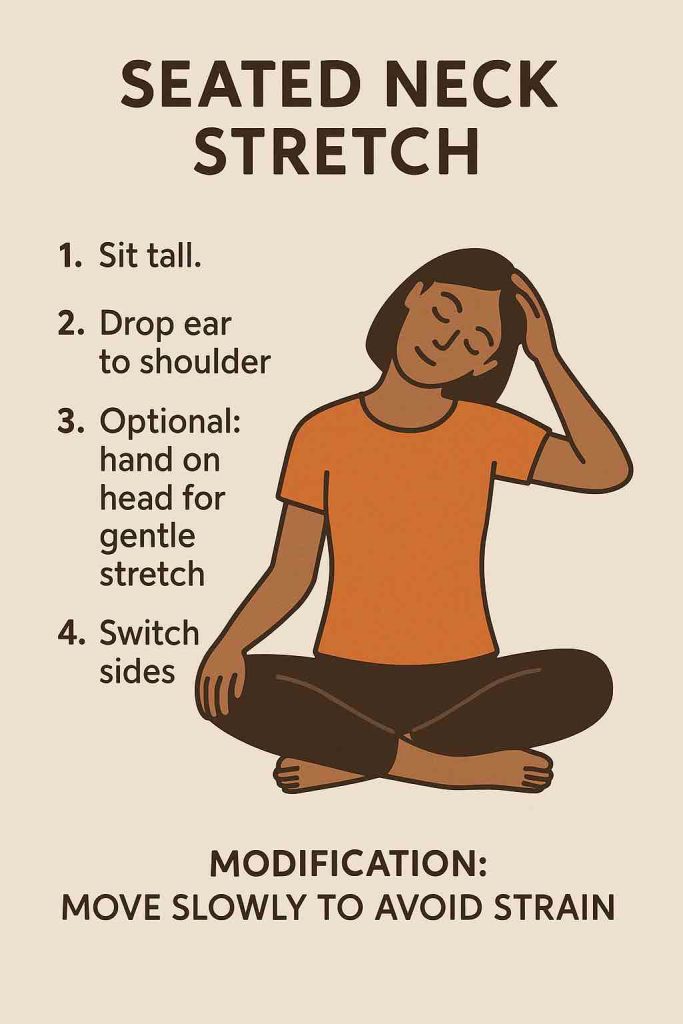
Breath Cue:
Exhale into any tightness.
Duration:
30 seconds per side.
Modification:
Move slowly to avoid strain.
Creating Your Yoga for Anxiety Routine
To get the best results, try this sample sequence:
- Easy Seated Pose (with breath awareness)
- Cat-Cow Stretch
- Standing Forward Fold
- Thread-the-Needle
- Supine Twist
- Legs-Up-The-Wall
- Alternate Nostril Breathing
- Savasana
Duration: 15-30 minutes
Frequency: 3–5 times per week
🧘♀️ The 15 Poses
| Pose | Benefit | Duration |
|---|---|---|
| Child’s Pose (Balasana) | Calms nervous system | 1-3 min |
| Legs-Up-The-Wall (Viparita Karani) | Lowers heart rate | 5-10 min |
| Cat-Cow Stretch | Releases back tension | 8-10 rounds |
| Seated Forward Bend | Soothes mind | 1-2 min |
| Bridge Pose | Opens chest | 30 sec – 1 min |
| Reclining Bound Angle | Deep relaxation | 3-5 min |
| Standing Forward Fold | Boosts circulation | 1-2 min |
| Corpse Pose (Savasana) | Full relaxation | 5-10 min |
| Easy Seated Pose | Mindful breathing | 5 min |
| Supine Twist | Releases tension | 1-2 min |
| Mountain Pose | Grounding | 30-60 sec |
| Thread-the-Needle | Shoulder release | 1-2 min |
| Supported Fish Pose | Chest opener | 3-5 min |
| Alternate Nostril Breathing | Balances nervous system | 2-5 min |
| Seated Neck Stretch | Relieves neck tension | 30 sec per side |
Bonus: 3 Breathing Tips for Instant Anxiety Relief
- 4-7-8 Breathing: Inhale 4, hold 7, exhale 8.
- Box Breathing: Inhale 4, hold 4, exhale 4, hold 4.
- Ocean Breath (Ujjayi): Inhale and exhale with a slight throat constriction for calming effect.
Conclusion
Yoga for stress and anxiety offers more than just physical flexibility — it’s a comprehensive system for calming the nervous system, quieting the mind, and building emotional resilience. Whether you’re dealing with daily stress or chronic anxiety, these simple yoga poses can offer you peace, clarity, and well-being.
Remember: consistency is key. Even 10 minutes of daily practice can transform your relationship with stress.
✅ 10 FAQs with Answers
1️⃣ What is the best time of day to practice yoga for stress and anxiety?
Answer:
The best time is when you can practice consistently. Many people find morning yoga helps set a calm tone for the day, while evening practice can help unwind before bed. Choose what fits your schedule and feels most calming.
2️⃣ How long should I hold each yoga pose for anxiety relief?
Answer:
Generally, holding each pose for 1–3 minutes allows your nervous system to relax. Some restorative poses like Legs-Up-The-Wall or Savasana can be held for 5–10 minutes for deeper relaxation.
3️⃣ Can I do these yoga poses every day?
Answer:
Yes. Daily gentle yoga is safe for most people and highly effective for managing chronic stress and anxiety. Always listen to your body, and rest if you feel fatigued.
4️⃣ Do I need any special equipment to start yoga for anxiety?
Answer:
You don’t need much. A yoga mat is helpful, and props like bolsters, blocks, or pillows can add comfort, but aren’t mandatory. You can easily modify most poses with items you already have at home.
5️⃣ Are these yoga poses suitable for complete beginners?
Answer:
Yes. This list of 15 poses was selected to be beginner-friendly, gentle, and easy to follow. They focus on relaxation, not intense flexibility or strength.
6️⃣ How does breathing affect anxiety during yoga practice?
Answer:
Breathing is central to yoga’s anxiety-reducing benefits. Slow, mindful breathing calms the nervous system, lowers heart rate, and helps release tension from the body and mind.
7️⃣ Can yoga replace medication for anxiety?
Answer:
Yoga can be a helpful complementary practice, but it should not replace prescribed treatment without consulting a healthcare provider. Always discuss any changes with your doctor.
8️⃣ Which yoga poses are best before bed for anxiety?
Answer:
Gentle poses like Legs-Up-The-Wall, Child’s Pose, Reclining Bound Angle, and Savasana are excellent before bed, helping promote relaxation and better sleep.
9️⃣ Can yoga help with panic attacks?
Answer:
Regular yoga practice may help reduce the frequency and intensity of panic attacks over time. During an active panic attack, simple breathing techniques and grounding postures like Child’s Pose can help calm the system.
🔟 How long before I see results from yoga for stress?
Answer:
Some people feel immediate relief after their first session. Long-term benefits typically build with regular practice over several weeks, improving resilience, emotional balance, and overall well-being.









